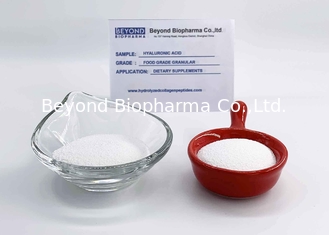White Hyaluronic Acid In Cosmetics / Hyaluronic Acid Collagen Plus Powder
Beyond Biopharma Hyaluronic Acid In Cosmetics Advantages
1 High safety
Ecocert certificatA
Non-animal origin bacterial fermentation
A series of safety tests carried out by authorized testing organizations
2 High purity
Very low impurities(such as protein,nucleic acid and heavy metal)
No pollution of other unknown impurities and pathogenic microorganism in production process assured by strict production management and advanced equipment
3 Professional Service
Customerized products
All-around technical support for HA applica-
tion in cosmeticvanced equipments
Quick Features of Beyond Biopharma Hyaluronic Acid In Cosmetics
| Material name |
Beyond Biopharma Hyaluronic Acid In Cosmetics |
| Origin of material |
Bacteria Fermentation |
| Color and Apperance |
White powder |
| Quality Standard |
Company Standard |
| Purity of the material |
>90% |
| Moisture content |
≤10% (105°for 2hours) |
| Molecular weight |
Around 1000 000 Dalton |
| Bulk density |
>0.35g/ml as bulk density |
| Solubility |
Perfect solubility into water |
| Application |
Cosmetic products, Skin care |
| Shelf Life |
2 years from production date |
| Packing |
Inner packing: Sealed Foil bag,1KG/Bag, 5KG/Bag |
| Outer packing: 10kg/Fiber drum, 27drums/pallet |
What are the benefits of HA for skin and Joint Health ?
Hyaluronic acids has many benefits for skin and joint cartilages. It mainly applied in Food dietary supplements industry, Cosmetic industry, and Pharma industry.
1. HA As New resources Food Ingredients
The application of hyaluronic acid in food originated in Japan. In 1996, Japan officially listed HA as an existing additive, and then began to develop continuously. At present, HA has become a household name in Japan. In addition to Japan, HA is currently widely used in dietary supplement products in the European and American markets. In China, sodium hyaluronate was officially approved by the Ministry of Health as a new resource food in 2018.
2 HA and skin beauty
With the increase of age, the body's ability to synthesize HA gradually declines. The decrease in hyaluronic acid content in the human body leads to loss of elasticity of the skin, wrinkles, joint pain, arthritis and other symptoms.
Taking HA orally can supplement the deficiency of HA in the body. It has been reported in foreign countries that with the isotope 14C-labeled HA, about 8.8% of HA is absorbed in the body after 7 days of continuous oral administration. Our manufacturer of HA also conducted a corresponding study on the absorption and efficacy of oral HA. The experiment confirmed that oral HA can supplement the deficiency of hyaluronic acid in the body, increase skin moisture, and keep the skin smooth and delicate. HA has become a typical ingredient in beauty products due to its good efficacy and synergy with collagen.
3. HA can supplement the deficiency of HA in the joint, increase the lubricity and viscoelasticity of the synovial fluid, inhibit the occurrence of inflammation, repair damaged cartilage, and promote joint health.
Typical Specification of Hyaluronic acid food grade Supplied By Beyond Biopharma
| ITEMS |
CONTROL LIMITE |
TESTING METHOD |
| Appearance |
White or similar white powder |
Visua |
| Molecular weight |
≥2.0 x 105 |
HPLC |
| Assay of sodium hyaluronate |
> T90% |
UV Method |
| Loss on drying |
Less than10% |
EP 2.2.32 |
| Glucuronic Acid |
≥44% |
UV Method |
| PH (1%H2O solution) |
6.0-7.5 |
EP2.2.3 |
| Heavy Metal |
NMT15PPM |
EP2.4.8 |
| Lead (Pb) |
≤5ppm |
ICP-MS |
| Arsenic (As) |
≤3ppm |
ICP-MS |
| Cadmium (Cd) |
≤1ppm |
ICP-MS |
| Mercury (Hg) |
≤1ppm |
ICP-MS |
| Protein |
≤0.1% |
EP |
| Transparency (0.1% solution) |
≥98.5% |
In-house method |
| Total viable aerobic count |
<1000CFU/g |
EP 2.6.12 |
| Yeast & Mold |
<100CFU/g |
EP 2.6.12 |
| Salmonella |
Negative in 10g |
EP 2.6.12 |
| E.Coli |
Negative in 1g |
EP 2.6.12 |
| Staphylococcus Aureus |
Negative in 1 g |
EP 2.6.12 |
| Particle size |
100% through 80 mesh |
In-house Method |

 Your message must be between 20-3,000 characters!
Your message must be between 20-3,000 characters! Please check your E-mail!
Please check your E-mail!  Your message must be between 20-3,000 characters!
Your message must be between 20-3,000 characters! Please check your E-mail!
Please check your E-mail! 



